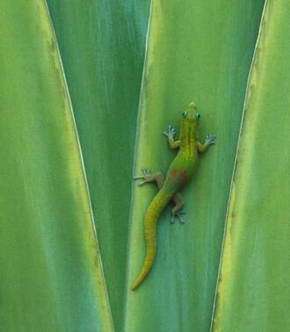Duct tape that never loses its stick

Gecko feet hold key to development of self-cleaning adhesives
Duct tape that never loses its stick. Bandages that come off without sticky residue or an "ouch." Gecko feet may hold the key to the development of synthetic self-cleaning adhesives, according to a biologist from Lewis & Clark College. The research is published in the January 3, 2005 online early edition of the Proceedings from the National Academy of Sciences of the United States, or PNAS.
“How geckos manage to keep their feet clean while walking about with sticky feet has remained a puzzle until now,” said Kellar Autumn, associate professor of biology at Lewis & Clark College. “Geckos don’t groom their feet, and the adhesive on their toes is much too sticky for dirt to be shaken off. Conventional adhesives like tape just get dirtier and dirtier, but we discovered that gecko feet actually become cleaner with repeated use.”
Autumn’s new research, published in PNAS, found that the microscopic adhesive hairs—or setae—that create the gecko’s adhesive qualities are also the first known self-cleaning adhesive. According to Autumn, gecko setae isolated from the gecko become cleaner by themselves.
“Our mathematical models suggest that self-cleaning in gecko setae is a result of geometry not chemistry,” said Autumn. “This means that synthetic self-cleaning adhesives could be fabricated from a wide variety of materials. The possibilities for future applications of a dry, self-cleaning adhesive are enormous. We envision uses for our discovery ranging from nanosurgery to aerospace applications. Who knows—maybe a gecko-inspired robot with sticky, self-cleaning feet will walk on the dusty surface of Mars someday.”
An interdisciplinary team of researchers, led by Autumn, earlier confirmed speculation that the gecko’s amazing climbing ability depends on weak molecular attractive forces called van der Waals forces, named after a Dutch physicist of the late 1800s. Van der Waals forces are weak electrodynamic forces that operate over very small distances but bond to nearly any material. Autumn’s research team rejected a 30-year-old model based on the adhesion chemistry of water molecules. Instead, the research team demonstrated that a gecko’s ability to stick to surfaces depends on geometry—not chemistry—to synthesize the world’s first gecko-based adhesive microstructure.
The setae (microscopic hairs) on the bottom of gecko’s feet are only as long as two diameters of a human hair. That’s 100-millionths of a meter long. Each seta ends with 1,000 even tinier pads at the tip. These tips, called spatulae, are only 200-billionths of a meter wide—below the wavelength of visible light. In 2002, Ronald Fearing, a researcher at the University of California at Berkeley, was able to produce two artificial hair tips, while Autumn and colleagues concluded that “both artificial setal tips stuck as predicted and provide a path to manufacturing the first dry, adhesive microstructures.” Fearing’s group later made the first array of synthetic gecko hairs with long stalks (6 micron stalk) and relatively large diameters (6 micron diameter).
The team’s research is supported by the National Science Foundation and the Defense Advanced Research Projects Agency (DARPA).
Source: Lewis & Clark College


















